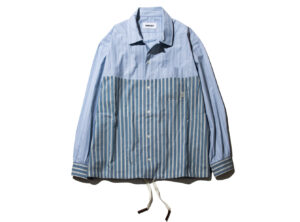In the current country/hip-hop landscape, where trap beats and braggadocious lyrics often dominate the charts, Shaboozey’s “A Bar Song (Tipsy)” offers a refreshing departure from the norm. The track, which blends elements of hip-hop, R&B, and classic soul, takes listeners on a reflective journey through late-night musings, the highs and lows of intoxication, and the pursuit of self-discovery. With its relaxed, almost hypnotic groove and candid lyrics, the song stands as a testament to the evolving nature of hip-hop, one that increasingly embraces introspection and emotional vulnerability.
Shaboozey, known for his genre-bending style and keen narrative sense, uses “A Bar Song (Tipsy)” to tackle themes of self-awareness, escapism, and the complex relationship between alcohol and the human psyche. This essay will analyze the song’s thematic and stylistic choices, positioning it within the larger context of hip-hop’s ongoing transformation and exploring its resonance with contemporary audiences.
A Lyrical Exploration of Intoxication and Escapism
“A Bar Song (Tipsy)” is, at its core, a meditation on the role of alcohol in moments of self-examination and social interaction. The lyrics navigate through a spectrum of emotions—from euphoria and carefree indulgence to introspective questioning and melancholic realizations. Shaboozey’s narrative voice shifts seamlessly between these states, capturing the disjointed thought processes and mood swings that often accompany drinking sessions.
The opening lines set the tone: “Pour me another one, I’m feeling fine / The bar’s half empty, but I’m losing track of time.” Here, Shaboozey establishes a dichotomy between the perceived joy of drinking and the undercurrent of existential disorientation. The imagery of an “empty bar” suggests solitude and detachment, while the act of “losing track of time” points to a deeper, more troubling loss of control. This push and pull between celebration and self-doubt is a recurring motif in the song, encapsulating the ambivalence that often defines nights spent drinking.
Alcohol, in “A Bar Song (Tipsy),” becomes both a facilitator of social interactions and a catalyst for introspective musings. Shaboozey’s lyrics fluctuate between scenes of revelry and moments of solitude, mirroring the duality of alcohol as a substance that can both connect and isolate. This nuanced portrayal is a significant departure from the simplistic glorification or condemnation of drinking that characterizes many contemporary hip-hop tracks. Instead, Shaboozey uses alcohol as a narrative device to explore the complexities of the human experience, lending the song a sense of depth and relatability.
The Rise of Vulnerability in Hip-Hop: Context and Influence
Shaboozey’s approach to lyricism in “A Bar Song (Tipsy)” aligns with a broader trend in hip-hop that has emerged over the past decade—a shift toward vulnerability and emotional openness. Artists like Kendrick Lamar, J. Cole, and Mac Miller have paved the way for a new kind of introspective rap that prioritizes honesty and self-reflection over traditional displays of bravado. This movement has opened the door for tracks like “A Bar Song (Tipsy)” to find resonance with audiences who crave authenticity and emotional depth.
The song’s introspective nature places it within this lineage of reflective hip-hop. Shaboozey’s willingness to delve into his own thoughts and feelings, however murky or contradictory they may be, speaks to a broader cultural moment where emotional transparency is valued. The track’s focus on personal struggle and existential questioning marks a departure from the hyper-masculine posturing that once defined much of hip-hop’s lyrical content. In this sense, “A Bar Song (Tipsy)” is emblematic of a genre in transition—one that is increasingly willing to explore the interiority of its artists and listeners alike.
A Modern Take on Nostalgia
Sonically, “A Bar Song (Tipsy)” draws from a rich palette of musical influences, blending hip-hop’s rhythmic foundations with the smooth, melodic sensibilities of R&B and classic soul. The production, characterized by its laid-back tempo, jazzy undertones, and sparse instrumentation, creates an atmosphere that is both introspective and inviting. The song’s instrumentation—highlighted by mellow keys, soft percussion, and a subtle bassline—evokes the feeling of a dimly lit bar, where the boundaries between inner thoughts and outer conversations blur.
This sonic aesthetic is deliberately nostalgic, conjuring up memories of earlier eras of hip-hop and R&B, while still maintaining a modern sensibility. The interplay between past and present is a hallmark of Shaboozey’s style, and in “A Bar Song (Tipsy),” it is particularly effective. The smooth production contrasts with the lyrical content, amplifying the sense of disjunction and disorientation that Shaboozey conveys.
The use of vocal effects and layering adds another dimension to the track. Shaboozey’s voice often drifts in and out of focus, as if mirroring the inebriated state he describes. This choice reinforces the song’s thematic exploration of altered perception and fluid reality, creating a listening experience that feels both immersive and disorienting.
The Bar as a Liminal Space
The setting of “A Bar Song (Tipsy)” is not merely a backdrop for Shaboozey’s lyrical narrative; it is a symbolic space that holds deeper meaning. Bars have long been depicted in music and literature as liminal spaces—places where the ordinary rules of social interaction and self-restraint are temporarily suspended. In the context of the song, the bar becomes a site of both escapism and confrontation, where Shaboozey grapples with his inner conflicts and the consequences of his actions.
The act of drinking in solitude or amidst strangers, as described in the song, carries its own set of connotations. It speaks to a desire to blur the boundaries of self and other, to find solace or understanding in the communal act of drinking. Yet, the sense of isolation that permeates the track suggests that such solace is often elusive. The bar, as a setting, amplifies these tensions, becoming a microcosm of the larger human condition—a place where people come together to be alone, where vulnerability is masked by bravado, and where joy and sorrow are often indistinguishable.
Shaboozey’s use of the bar setting can be seen as a metaphor for the contradictions of contemporary life, where the pursuit of pleasure is often intertwined with the fear of emptiness. This duality is captured in the ebb and flow of the song’s lyrics and instrumentation, making “A Bar Song (Tipsy)” both a narrative of personal experience and a commentary on broader societal themes.
In “A Bar Song (Tipsy),” Shaboozey offers a multifaceted exploration of selfhood, escapism, and the complexities of human emotion. The track’s blend of introspective lyrics, nuanced production, and thematic depth places it firmly within the lineage of hip-hop’s ongoing transformation toward greater emotional transparency and vulnerability. By using the bar as a symbolic space for self-reflection and existential questioning, Shaboozey creates a narrative that resonates with contemporary audiences who are increasingly drawn to authenticity and relatability in music.
The song’s ability to evoke nostalgia while remaining relevant to modern sensibilities speaks to Shaboozey’s skill as a storyteller and musician. “A Bar Song (Tipsy)” is not just a track about drinking; it’s a meditation on the human desire for connection, the fear of loneliness, and the search for meaning in a world that often seems indifferent. As hip-hop continues to evolve, songs like this one demonstrate the genre’s capacity to capture the complexities of life with honesty and artistry, making it a powerful medium for both personal expression and cultural critique.
No comments yet.








